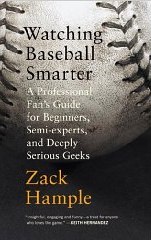Watching Baseball Smarter
by Zack Hample
A respected baseball writer Twittered that he learned a lot from this book. I think he was being more than somewhat generous, because I myself am a rather casual fan and I knew most of the things in his book by the time I was in sixth grade – and so did every other boy in the class. (This was the dark ages, when girls weren’t expected to know important stuff like batting averages until their late teens.)
OK: I did get two two things wrong. If a ball deflects off the pitching rubber and goes into the dugout, it’s a foul ball. I’ve never seen it happen, I'm not sure it could happen, but OK, when I took the 12-question foul-ball quiz, this one got me. And, yes, I’ve believed since sixth grade that errors did not count as a time at bat and this turns out not to be the case. Some sixth grader misinformed me. Don’t think I don’t remember who.
The book’s subtitle, “a professional fan’s guide for beginners, semi-experts, and deeply serious geeks” is wrong. This is what we, in sixth grade, would have called “a book for girls” — that is, a book for people who don’t really know much about baseball but might like to watch it. For that, it’s a fine book. (We will not mention at this point that the evening guy on WEEI dropped the ball on a question about the infield fly rule the other night.) I wouldn’t mind having the soccer version of this book, or the cricket edition. I once watched a Rugby final in Sydney, and it sure would have helped to have a pleasant and amiable read like this.
It’s a shame, though, because there’s a ton of interesting stuff about baseball that I’d like to know. Here are a few:
- What is the best way to score a game at home? In a modern radio booth, who scores the game? On paper? On computer?
- Do teams really differ in teaching fundamentals? How? People used to talk about the Orioles as being driven by fundamentals; true? What about scouting philosophies?
- Some teams have had historically bad runs: the Cubs, the Pirates, and the Orioles have all had a rough time in their own way. In the past, you could point to Cleveland after the Colavito trade, or the Phillies after the breakup. Why were each of these teams so bad? Was it just luck, or poor judgment, or a fundamental misunderstanding?
- Hample says that modern batters, following Ted Williams, do not deign to take advantage of the overshift. That’s not true: the modern overshift, as I understand it, was revived for David Ortiz, and he does try to go to the opposite field, or bunt. He generally fails, but it sure looks like he’s trying. Am I wrong?
- Hample says the last left-handed catcher was a Pirate in ’89; I could have sworn that the Red Sox used a southpaw emergency catcher more recently.
- Someday, a woman will play in the majors. What will her position be? (My bet is 2B, but you could make a case for C)
- OBS strikes me as a bastard statistic; you can’t add two ratios and expect the sum to mean much. What says the defense?
- What are the odds that a runner on first, no outs, will score? How about the expectation value for an inning with the bases loaded, 2 out?
- In the late 1980’s, Bill James started an analytic revolution. How has this changed the game? How has it failed to change the game? Where has it proven wrong?
- There are dozens of little things players do, because something that never happens might happen. Third basemen are supposed to back up the pitcher after a pickoff play. On a popup to short center with a man on first, who covers second in case the runner tags? A compendium of these little things would be nice to have.
- How exactly do options work? (In the next labor negotiation, should the union demand a way for players to get more options? Or should the owners?) Why do teams want to name players later?
- How do baseball fundamentals differ in other places? What strategic moves might you see in Korea or San Pedro de Macoris that you don’t see in the Bronx?
